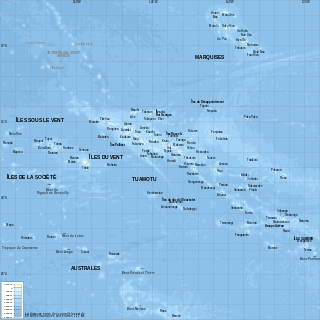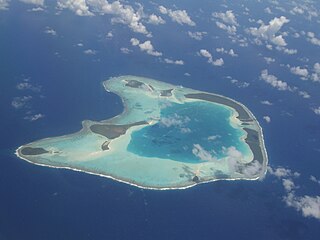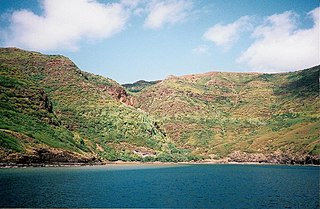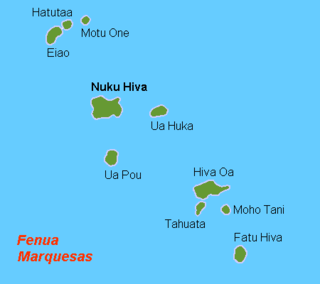Related Research Articles

French Polynesia is located in Oceania. It is a group of six archipelagos in the South Pacific Ocean, about halfway between South America and Australia. Its area is about 4,167 km2, of which 3,827 km2 is land and 340 km2 is (inland) water. It has a coastline of 2,525 km but no land borders with other countries.

The Marquesas Islands are a group of volcanic islands in French Polynesia, an overseas collectivity of France in the southern Pacific Ocean. Their highest point is the peak of Mount Oave on Ua Pou island, at 1,230 m (4,035 ft) above sea level.

Tetiʻaroa is an atoll in the Windward group of the Society Islands of French Polynesia, an overseas territorial collectivity of France in the Pacific Ocean. Once the vacation spot for Tahitian royalty, the islets are under a 99-year lease contracted by Marlon Brando, and are home to The Brando Resort.

Motu One is the name of a small sandbank with no vegetation, located on the western edge of a coral reef; the only atoll in the Marquesas Islands.

Hatutu is a small island approximately 3 km (2 mi.) northeast of Eiao in the northern Marquesas Islands. It is approximately 3 km from Eiao by a channel 50 meters deep. It was also known by the names Hancock, Chanal, Langdon, and Nexsen

Eiao is the largest of the extreme northwestern Marquesas Islands. The island is uninhabited, but is administratively part of the commune (municipality) of Nuku-Hiva, itself in the administrative subdivision of the Marquesas Islands.

The Marquesan Nature Reserves are a network of small nature reserves in the Marquesas Islands. The reserves were declared by the government of French Polynesia in 1992, as a first step toward preserving the native flora and fauna of some of the smaller islands of the group.
The Motane One Reserve is a nature reserve containing the whole of the islands of Moho Tani and Terihi, as well as the surrounding rocks, in the southern Marquesas Islands. It was declared in 1992, as the first step toward protecting the ecosystem, much of which, on Moho Tani, has been destroyed by over-grazing by feral sheep, pigs and goats. Terihi and the smaller rocks are home to large seabird rookeries. The island and its ecological disaster is mentioned by Thor Heyerdahl in his book Green Was the Earth on the Seventh Day.
The Hatutu Nature Reserve is a nature reserve encompassing the whole of the island of Hatutu in the northern Marquesas Islands. The reserve was declared in 1971, and is the primary nesting site of several endangered species, several of which are endemic, including the Hatutu Marquesan warbler and the Marquesas ground dove. The Hatutu Nature Reserve is home to one of the most important nesting grounds for the blue-footed booby.
The Hatutu Marquesan warbler, also called the Hatutu Polynesian warbler or the long-billed Polynesian warbler, is a subspecies of the northern Marquesan reed warbler. The subspecies is endemic to the island of Hatutu, and one of the primary breeding species in the Hatutu Nature Reserve.
The Eiao Marquesan warbler is a subspecies of the northern Marquesan reed warbler found only in the dry upland forest on Eiao in the northern Marquesas Islands.

The Eiao Nature Reserve is a nature reserve encompassing the whole of the island of Eiao in the northern Marquesas Islands, as well as several surrounding rocks.

Motu Iti is one of the northern Marquesas Islands in French Polynesia. Located west-northwest from Nuku Hiva, Motu Iti is the site of extensive seabird rookeries.

Vaituha is a small valley in northwestern Eiao in which a small watersource empties into a small bay of the same name. This bay is one of two reliable anchorages on Eiao. The depth of the bay is 27 meters.

Ua Huka is one of the Marquesas Islands, in French Polynesia, an overseas territory of France in the Pacific Ocean. It is situated in the northern group of the archipelago, approximately 25 mi (40 km) to the east of Nuku Hiva, at 8°54′S139°33′W.

The Diocese of Taiohae is a Latin Church ecclesiastical jurisdiction or diocese of the Catholic Church in French Polynesia. It is a suffragan diocese in the ecclesiastical province of the Archdiocese of Papeete, yet still depends on the missionary Roman Congregation for the Evangelization of Peoples.
Mangareva, Mangarevan is a Polynesian language spoken by about 600 people in the Gambier Islands of French Polynesia and by Mangarevians emigrants on the islands of Tahiti and Moorea, located 1,650 kilometres (1,030 mi) to the North-West of the Gambier Islands.

This page list topics related to French Polynesia.

Fa'ahia is an early Polynesian occupation site in the north-east of the island of Huahine, in the Society Islands, French Polynesia. With the neighbouring Vaito'otia site, it dates to between 700 CE and 1200 CE. Because much of the site is waterlogged, artefacts made of organic materials have been well preserved, including wooden patu hand clubs, canoe parts and adze handles.
References
- ↑ "Ilôt de Sable, French Polynesia". SPREP. Retrieved 3 January 2023.